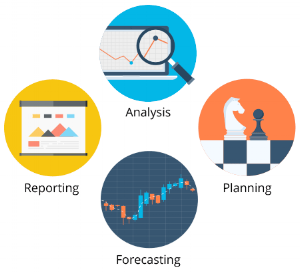Management reporting
An effective reporting system is a source of business intelligence that enables managers to make informed decisions based on accurate information. Management reports focus on informing managers about various aspects of the business, helping them make better-informed decisions and plan further actions. Data is collected from different sectors of the company by tracking key performance indicators (KPIs) and presenting them in an understandable manner.
It is important to note that management reporting differs from financial reporting. Both types of reporting are significant, but management reporting is tailored to the internal needs of the company for information used in the decision-making process.
Companies are under increasing pressure to expand the depth, accuracy, and detail of financial and management reporting. Managers, investors, shareholders, auditors, and other stakeholders want to know more than what happened—they want to understand why a particular result occurred. On the other hand, analysts need to quickly present this information so that the company can respond to issues or seize opportunities before the moment is lost. Interactive reporting and dashboards should ensure a detailed insight into the company's operations, the causes of certain results, and provide this information in real-time, allowing the company to take action today.
Reports are usually created by the finance department as well as analysts from other company sectors who provide the necessary inputs for processing quantitative and qualitative results.
Why is it necessary to improve reports?
When does the problem with reporting arise? Mainly with the amount of information. Every day, hundreds or even thousands of invoices are entered, multiplying the demands for information. Without knowledge about sales, margins, seasonality, deviations from the plan, and many other pieces of information, it is impossible to make the right decisions.

Reasons why reports are not used effectively can include:
- An overwhelming amount of information in the report
- Confusing visualization
- Inability to identify the main reasons for a certain result
- Analysis of irrelevant KPIs
- Data is difficult to interpret
- Data is not entirely accurate
- Key trends are hard to recognize
- Lack of conclusions and action plans
- Inability to identify strategic opportunities for the company
Problems:
Unfortunately, sometimes these relevant pieces of information are not obtained quickly. Large databases, numerous overlapping activities, different information systems that are not integrated, and slow information flows are just some of the factors that hinder a manager from receiving information on time. And decisions need to be made as quickly as possible. One of the greatest internal strengths of any company is the ability to produce accurate information that enhances business results. Power and success lie in information.
Solution:

Reports provide feedback on achieved results and serve as a basis for making business decisions. Reports must be comprehensive, understandable to the user, easy to analyze, and action-oriented. Additionally, the report must be interactive to allow tracking and comparing different categories. All of this should take as little time as possible for managers and decision-makers.
The management reporting system shapes reports designed to answer the question, "Why is this information important for the manager?" The system's goal is to ease daily processes and provide a solid foundation for the company to create growth. We do this by identifying the most relevant indicators and key performance indicators (KPIs) for your specific business. Our main focus is on facilitating data interpretation, highlighting key trends, and identifying future opportunities.
Our tools are tailored to the client's needs, enabling better tracking of strategic goals and performance, as well as identifying future opportunities in their industry.
An effective report contains:
- Comprehensive analysis of company performance
- Insight into relevant KPIs that elevate the company to a higher trajectory of development
- Effective visualization of information
- Clearly presented information
- Easily interpretable information
- Key trends clearly highlighted
- Future opportunities clearly identified
- Conclusions and action plan suggestions
What do we achieve?
- Clearly defined set of complete reports:The set of reports includes revised reports, templates for filling out reports, and precise standards in report creation.
- Separated financial and operational reports:The company gains insight into both financial and sector performance.
- Multidimensional reporting:The management reporting system includes the ability to quickly filter, group, and track information to meet different demands. Therefore, tracking across different dimensions is vital. Possible dimensions include projects, customers, regions, facilities, sectors, vendors, items, employees, and specific dimensions relevant to the industry.
- Comparison of different information flows: Reports enable comparison of actual (ACT) information with planned (BUD) and with previous years or forecasts.
- KPI analysis:All relevant KPIs are integrated into the system, forming the basis for decision-making.
- Flexible reporting:Reports can be improved as information demands grow.
- Visual content: Create dashboards that include tables, charts, and highlighting elements.
- Unified database: All reports in one place.
- Filters in the dashboard: Use filters to track different information by dimensions.
Benefits of a management reporting system

- Effective report sets that encompass the entire company
- Linked interactive reports
- Visual data (tables, charts, animations)
- Analytics related to main information flows (planned data, historical data, and forecast)
- Report sets enable significant time savings when updating data in future periods
- Ability to share partial information depending on the needs of different users
- All reports are tailor-made and adapted to the specifics of the company and the industry in which it operates
- AIM Institute's support in system implementation and its upgrade
